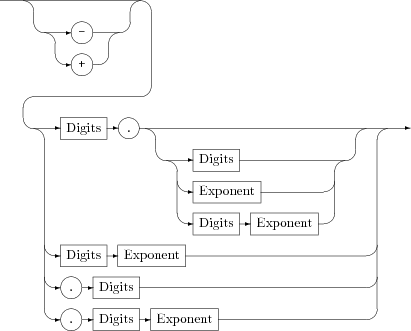Floating point and decimal literals
There are several forms of floating point literals.
DecimalLiteral
FloatLiteral
Digits
Exponent
Floating-point literal values can take one of the following forms:

Optional sign, integer digits followed by an exponent.

Optional sign, integer digits, a decimal point, and an optional exponent,

Optional sign, integer digits, a decimal point, fraction digits, and an optional exponent.

Optional sign, a decimal point, fraction digits, and an optional exponent.
If the sign is omitted, ’+’ is assumed. If the exponent is omitted, e0 is assumed.
The exponent is the letter ’e’ followed by an optional sign, and one or more decimal digits.
Examples
f := 0.0;
f := 1.;
f := 200128.00005
f := 3.14159265358979;
f := 1e4;
f := 1e-4;
f := 10000e0;
f := .1234;
f := .1234e4;
f := 1.E-32;
f := 1.E-032;
f := 6.0221415E23;
f := 1.7976931348623157e308;
The largest positive floating point literal value that can be represented in EPL is 1.7976931348623157 * 10308. The smallest positive nonzero value that can be represented is 2.2250738585072014 * 10-308. If you write a floating-point literal whose value would be outside the range of values that can be represented, the compiler raises an error.




